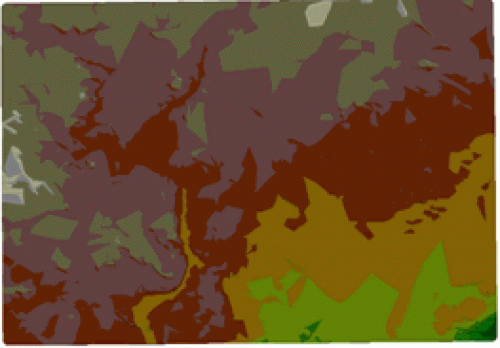Contact the Geospatial Centre
Dana Porter Library, Room 328
University of Waterloo Library
Waterloo, Ontario N2L 3G1
Email: librarygeo@uwaterloo.ca
This data resource provides a digital elevation model (DEM) with 30 metre intervals. This model is based on the NTS 1:50,000, and 1:250,000 map sheets. Index (JPG) shows DEM coverage available through DMTI. The Geospatial Centre has access to DMTI's data and is available upon request. For assistance in working with DMTI's DEM data, please consult Working with DMTI digital elevation models (PDF). Digital Elevation Points are also available at 1 metre intervals.
These data sets are available in both Universal Transverse Mercator (UTM) and geographic (lat/long) co-ordinates; horizontal datum is North American Datum (NAD) 83. These data are stored as ASCII files, but are also available as ArcInfo Grid, Vertical Mapper (MapInfo ".grd" files), and Planet (UTM projection only) files. Please see the Converting digital elevation models (DEM)(PDF) guide for a brief outline on how to use this data in ArcGIS. Other data formats can be accommodated, as the Geospatial Centre has access to a number of conversion utilities.
To request this data, please fill out the Ask-Us form and include which layers (shapefiles) you are interested in obtaining. The dataset will be shared with you via OneDrive upon completion of the data release agreement form. You may also make an in-person appointment using the same form.
These data are provided for personal use for academic, research, and/or teaching purposes. A data release agreement must be agreed to before these licensed data can be released. DMTI Spatial must be acknowledged on any derivative product, whether printed or electronic, including for example, a printed map, a raster or vector graphic, a web-based application, etc. Patrons are advised to fully respect the provisions of Canada's Copyright Act as well as terms and conditions imposed by the data provider.
DMTI Digital Elevation Model [computer file]. Markham, Ontario: DMTI Spatial Inc. , [2011].

Data courtesy of DMTI
Dana Porter Library, Room 328
University of Waterloo Library
Waterloo, Ontario N2L 3G1
Email: librarygeo@uwaterloo.ca
The University of Waterloo acknowledges that much of our work takes place on the traditional territory of the Neutral, Anishinaabeg, and Haudenosaunee peoples. Our main campus is situated on the Haldimand Tract, the land granted to the Six Nations that includes six miles on each side of the Grand River. Our active work toward reconciliation takes place across our campuses through research, learning, teaching, and community building, and is co-ordinated within the Office of Indigenous Relations.